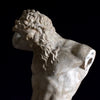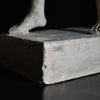A Fine 19th Century Plaster Statue of Marsyas. Cast by Domenico Brucciani 1815-1880
£0.00
A exceptional fine cast plaster figure of the Satyr Marsyas.
Cast by renowned sculptor Domenico Brucciani & Co London between 1837-1880. The base with inventory number 269. Most certainly cast from the original 50BC Greek Bronze displayed in the British Museum.
Overall in good order. Scuffs and scratches mainly to the base, Areas of Inconspicuous restoration. Loss of separately cast arm.
Height 87cm, Base 32cm x 24cm.
Domenico Brucciani was born in Lucca, Italy in 1815. established one of the most famous and influential plaster firms of the Victorian era. He moved to London where he established a Gallery of Casts in Covent Garden by 1837. This business was one of many which emerged in the 19th century, when the copying of art became a lucrative trade across Europe. Brucciani’s firm, working for the British Museum and the South Kensington Museum (now the Victoria & Albert Museum). Both institutions assembled important collection of casts of sculpture and architecture during this period.
Marsyas, legendary Greek figure of Anatolian origin. According to the usual Greek version, Marsyas found the aulos (double pipe) that the goddess Athena had invented and thrown away and, after becoming skilled in playing it, challenged Apollo to a contest with his lyre. The victory was awarded to Apollo, who tied Marsyas to a tree and flayed him. His skin was displayed at Calaenae in southern Phrygia as the Greek historians Herodotus and Xenophon report. According to the 2nd-century-AD Greek writer Hyginus, King Midas of Phrygia was given asses’ ears by Apollo when he voted for Marsyas. A common version of the story tells of a similar musical contest between Apollo and Pan. In Rome a statue of Marsyas, a favourite art subject, stood in the Forum; this was imitated by Roman colonies and came to be considered a symbol of autonomy.

























Share this item: